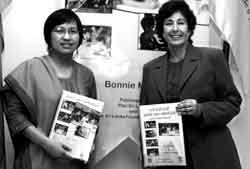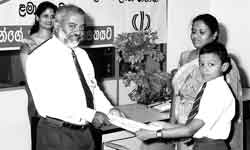|
|
|||||||||
|
Education – the key to a child’s future
“No matter how young they are, children should be allowed to actively participate in their own development – at home, school and society,” asserts Plan Sri Lanka’s Country Director, Myrna Evora. They can contribute significantly, as they are honest, sincere and true to their commitments, she explains, of this issue close to her heart. Child participation is something that Plan International has increasingly advocated through all their programmes on education, water and sanitation and child protection, since they began work in Sri Lanka. Myrna has come to the end of her four-year tenure in Sri Lanka, and it is with a sense of fulfilment that she prepares to take on additional responsibilities as Plan’s Regional Director – Asia, based in Bangkok, come July 2006. In the 22 years that she has been with Plan, Myrna has served in her home country of Philippines, Bolivia, Indonesia and Sri Lanka, working on child-related issues, in keeping with their motto – ‘The child is in the heart of everything we do’. “We do not want to duplicate the work of the government, but rather support government institutions to provide a better quality of education for all sections of society,” she said. Myrna knows from experience that children can participate in most aspects of development. She cites an example where students had been involved in monitoring and evaluation of a domestic latrine construction project. “What would have normally taken three months was completed in 22 days,” she recalls. Substantial progress is also visible in Plan’s educational activities. Redesigning of classrooms, desks, partitions, toilets (1:50 rather than 1:300 as was the case in most schools), activity corners, visual aids, wall newspapers, etc. are all part of Plan’s framework for a child-friendly school.
The biggest challenges Myrna had to face was in the aftermath of the tsunami. Going to Hambantota region, one of the worst affected, within 24 hours, she organised immediate assistance providing drinking water and food, and later school supplies, apart from making a large donation to the government for immediate relief. Having worked extensively in Hambantota previously, Plan felt responsible for the region and hence concentrated their efforts there. “With so many players, we decided to choose one district rather than spread thinly.” A large residential school to accommodate 3000 students, which they hope will operate as a Centre of Excellence is being constructed. With the best of facilities – academic, sports, science, etc., it would cater to primary and secondary school children, including those from the abandoned schools in the area. “Disaster preparedness, disabled friendly training facilities and latest equipment are aspects being considered in the school that will be officially handed over to the government in October 2007,” Myrna says. Looking back, she admires Sri Lanka’s ability to recover from the calamity, which she says was faster and better than other countries. “I admire Sri Lankans for the way they have responded and helped each other.” Of the on-going conflict, she says, “Regardless of their ethnicity, all people want peace, and while every child needs education, all parents need to regain their livelihood to ensure economic security for the entire community.” Plan has also worked with the corporate sector in providing unique opportunities for children. Believing that the newspaper can be an effective teaching aid, Plan gives 50,000 copies of the children’s educational paper – Wijeya every Tuesday to the children in the schools that they support. “We have 100% attendance on those days,” she says. Plan that has no religious, political or government affiliation, today supports 27,000 children. It is with mixed feelings that Myrna prepares to leave Sri Lanka, a land that she has come to love. Although she feels satisfied with her efforts over the past four years, she thinks there is much more that Plan can do. “I can do more for Sri Lanka at a strategic level in my new post,” she assures.
Rewarding the best One hundred and eighty one students from all parts of the country have once again received large sums of money as prizes, for outstanding results at the Year Five scholarship examination, from the Commercial Bank of Ceylon.
Students who held a Commercial Bank Arunalu minors' savings account and were placed among the top three in their respective schools at the 2005 scholarship examination won Rs. 10,000 (first place), Rs. 7,500 (second place) and Rs. 5,000 (third place).The Bank paid Rs. 1.35 million in prize money to these account holders, an 88 percent increase from the Rs. 715, 000 paid last year to 84 Arunalu accountholders. The Head of Marketing of Commercial Bank Richard Rodrigo said, “We commenced this scholarship scheme to reward students from all corners of the country for their hard work and determination to be the best in their respective fields of study. This savings scheme has become very popular with parents, who have their children's best interests at heart and want to inculcate the saving habit in them.” The Arunalu children's savings scheme was launched in 1998 by the Bank with the objective of promoting academic excellence from a young age, while encouraging the savings habit. Arunalu accounts can be opened at any of Commercial Bank's 137 branches or supermarket counters with a minimum deposit of Rs. 100. A minimum account balance of Rs. 5,000 should be maintained at the time of the examination to be eligible for a prize.
Hand in hand
Embroidered sarees, wall hangers, attractive patchwork garments, all caught the eye of the visitors at the Lasallian Community Education Service (LCES) auditorium on May 25. Standing proudly by their work were the students of the Socially Useful Productive Work Section of LCES, who had organised the exhibition as a fund-raiser to support needy students at the institute.
Shahila Salaam, who has been a student in the dress-making section for one year, said they had spent nearly eight to ten months preparing for this exhibition. “We wanted to do something different,” she said. Shahila said they hoped they would get orders, so that they could earn a living through their skills. The students of the LCES have a choice of courses from knitting and cookery to beauty culture and painting, each with its own syllabus. Sellathur Rohini, 28, began studying beauty culture, sewing and patchwork at LCES four months ago. She said that whatever she earned from the exhibition would go to help poor children. Their teacher Indrani Muller had given them the idea to hold this exhibition. |
|||||||||
Copyright © 2006 Wijeya Newspapers
Ltd. All rights reserved. |


